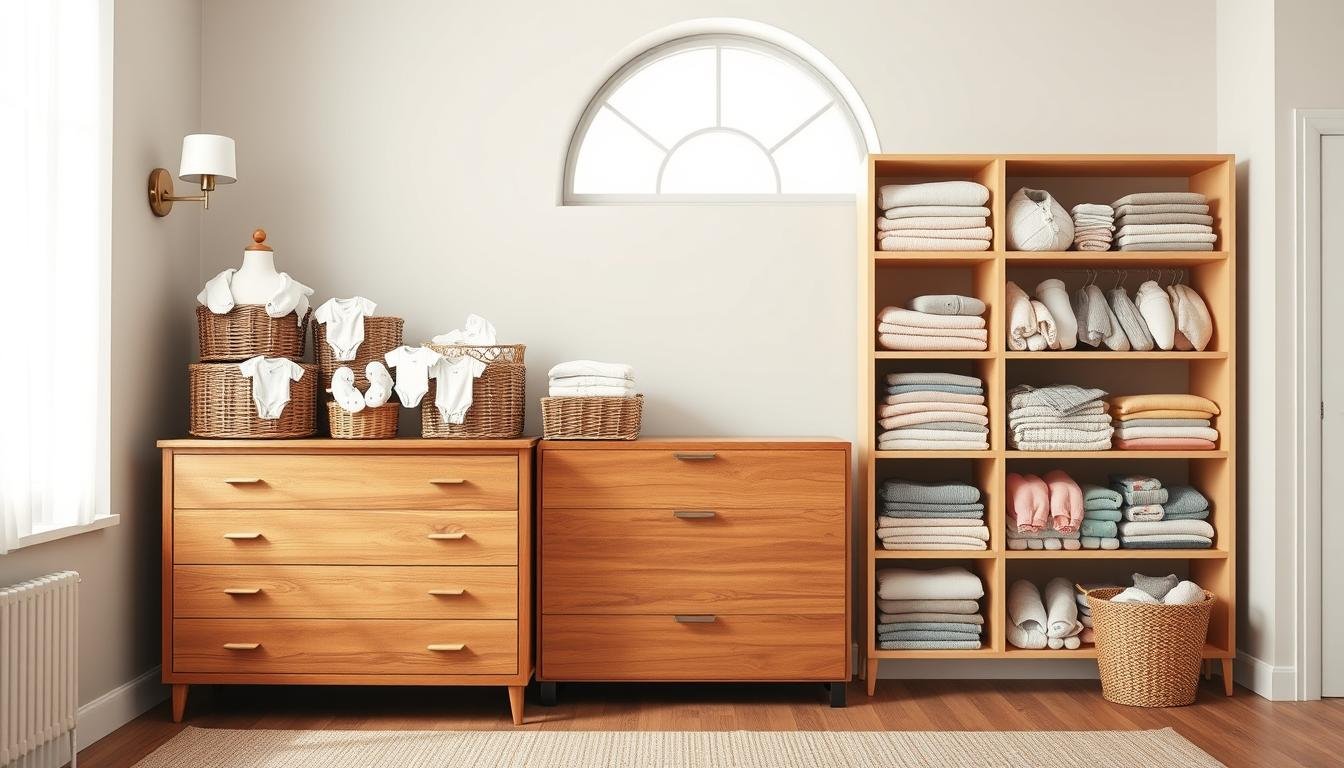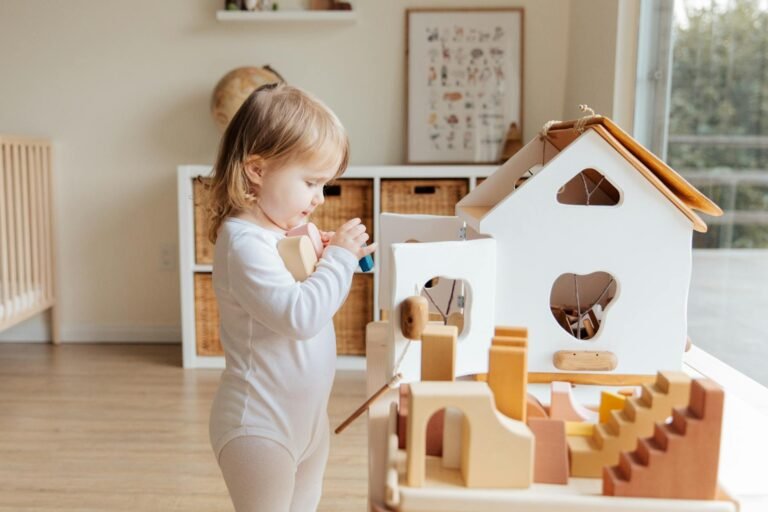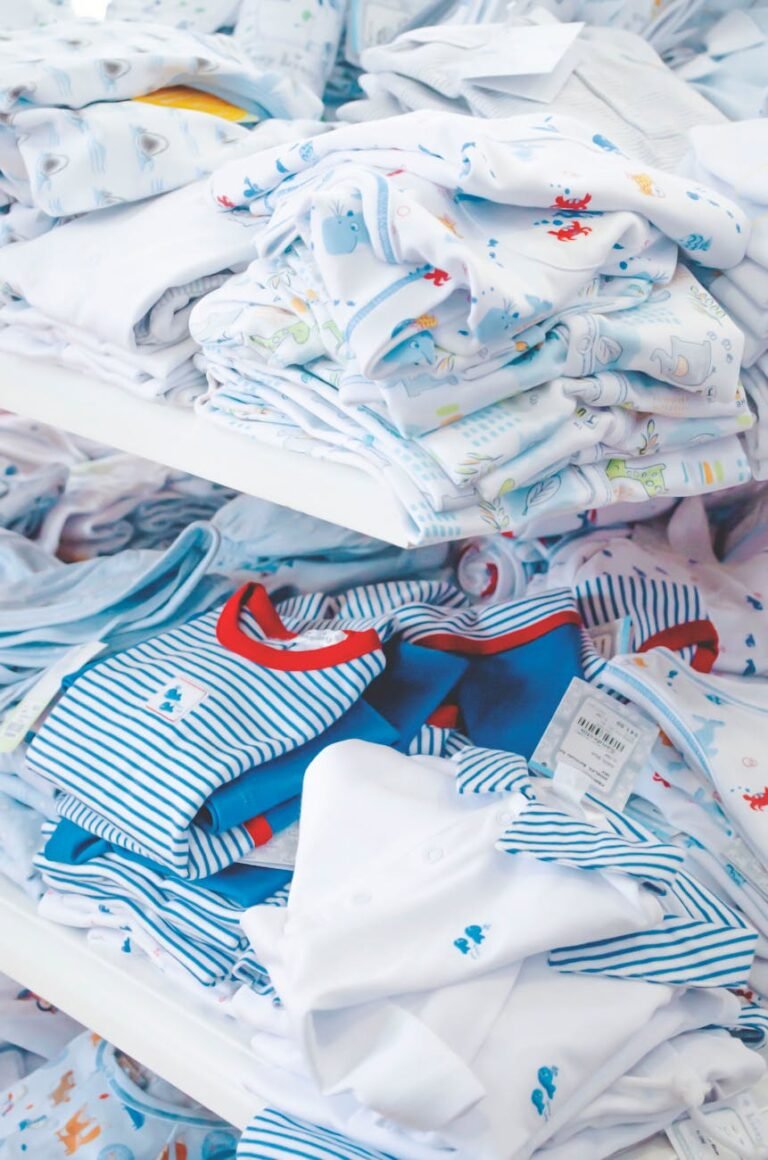Have you ever wondered how to keep those tiny, sentimental baby clothes for future generations or donations?
Babies grow fast, often outgrowing their clothes every one to two months in the first year. To keep these precious items in great shape, good storage practices are key. This is true whether it’s for a cherished christening gown or to avoid clutter from unused outfits.
By the end of this guide, you’ll know how to keep baby clothes fresh for future use. We’ll talk about choosing the right storage containers and saving space. Let’s start this journey to protect those adorable baby garments!
Key Takeaways
- Proper storage of baby clothes helps in maintaining their condition and value.
- Effective storage involves choosing the right materials and environment.
- Laundry and drying techniques are crucial before packing the clothes.
- Plastic containers are favored for their mold and mildew prevention.
- Implementing a labeling system can ease future retrieval.
- Periodic inspection of stored clothes can prevent permanent stains.
Understanding the Importance of Proper Storage
We’ve been organizing kids’ clothes for over 10 years. We know how important storage is for keeping baby clothes in good shape. Without the right care, clothes can get damaged and not be usable anymore. With our three boys, we have lots of clothes to keep track of. This shows how key it is to use good storage tips.

Why Proper Storage Matters
Storing clothes right is crucial for their care. If we don’t do it right, clothes can get damaged, lose color, and even get pests. It’s important to keep clothes at a certain temperature and humidity level. This stops mold and mildew from growing.
Using acid-free tissue paper helps prevent clothes from yellowing. It keeps them looking good for a long time.
Statistics show that about 2/3 of 4T clothes unboxed during summer turn out to be winter clothes, illustrating the challenges of seasonal storage.
We sort all boys’ shirts into types. This makes it easy to find what we need and keep track of our clothes.
Common Issues with Improper Storage
Storing clothes wrong can cause many problems:
- Mold and Mildew: Damp places can make mold grow. Plastic bins or bags without air can trap moisture, making it worse.
- Pest Infestations: Stains and bad sealing can attract insects. This can damage clothes that are still in the bag.
- Fabric Degradation: Without acid-free materials or the right temperature, fabrics can get weak and colors can fade.
Changing to a type-based system has really helped us. We use cotton muslin bags, acid-free boxes, and silica gel packs to protect our clothes.
Good storage is more than just putting clothes in bins. It’s about creating a space that keeps clothes looking great. By following these tips, you can keep your baby clothes in perfect condition. They’ll be ready for the future or to be passed down as special gifts.
| Common Issues | Optimal Solutions |
|---|---|
| Mold and Mildew | Use silica gel packs; maintain appropriate humidity levels |
| Pest Infestations | Ensure clothes are clean; use natural moth repellents |
| Fabric Degradation | Use acid-free tissue paper; keep at stable temperature |
Good storage tips are key for baby clothing care. Knowing the common problems and using smart storage solutions helps keep these special items safe for a long time.
Preparing Baby Clothes for Long-Term Storage
Preparing baby clothes for the future is key. Start by washing and drying them right. This keeps them in great shape for years. Here are the main steps for successful storage.
Laundering Guidelines
First, clean the clothes well. Use gentle, fragrance-free soap to avoid damage. Make sure to rinse each item well to remove all soap.
For delicate fabrics, hand-washing or a gentle machine cycle is best. This helps keep the fabric strong during storage.
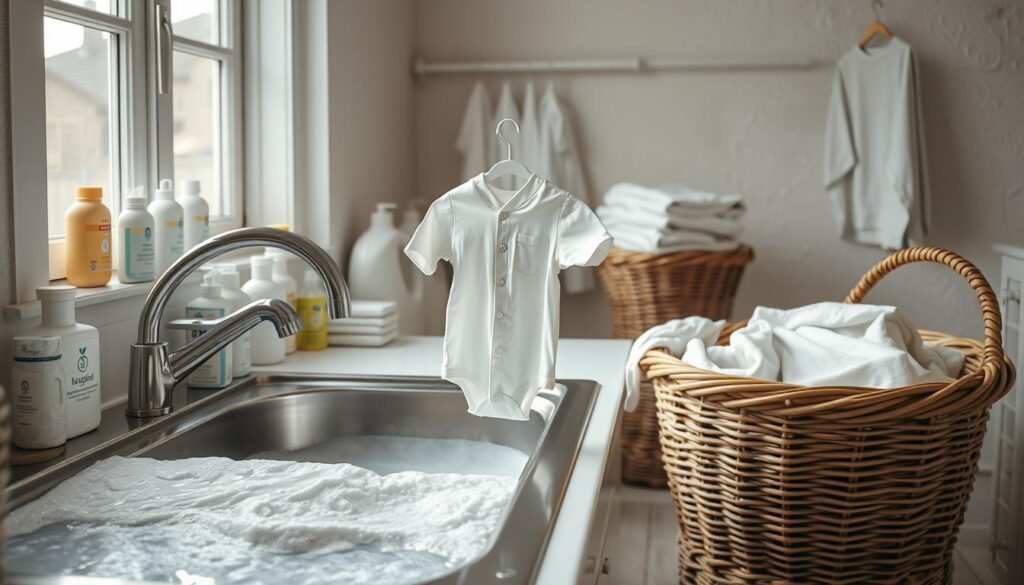
Drying Techniques
After washing, drying is just as important. Dry clothes in the shade to keep colors bright and fabrics strong. If you must use a dryer, set it to low heat.
Make sure clothes are dry before storing. This stops mildew and mold. Juujbox says keeping clothes dry is crucial.
The Role of Fabric Softener in Storage
Fabric softeners can harm clothes over time. They make clothes feel soft but can attract dirt. For long-term storage, skip fabric softeners.
Use acid-free tissue paper to protect clothes. This prevents creases. Juujbox offers special storage to keep clothes safe all year.
For more tips on storing baby clothes, check our guide. Follow these steps to keep your clothes in great shape for years.
Choosing the Right Storage Containers
Choosing the right storage containers for clothes is key. It keeps baby clothes safe from moisture, pests, and light damage. This way, clothes stay in great shape for later use or to keep as a keepsake.
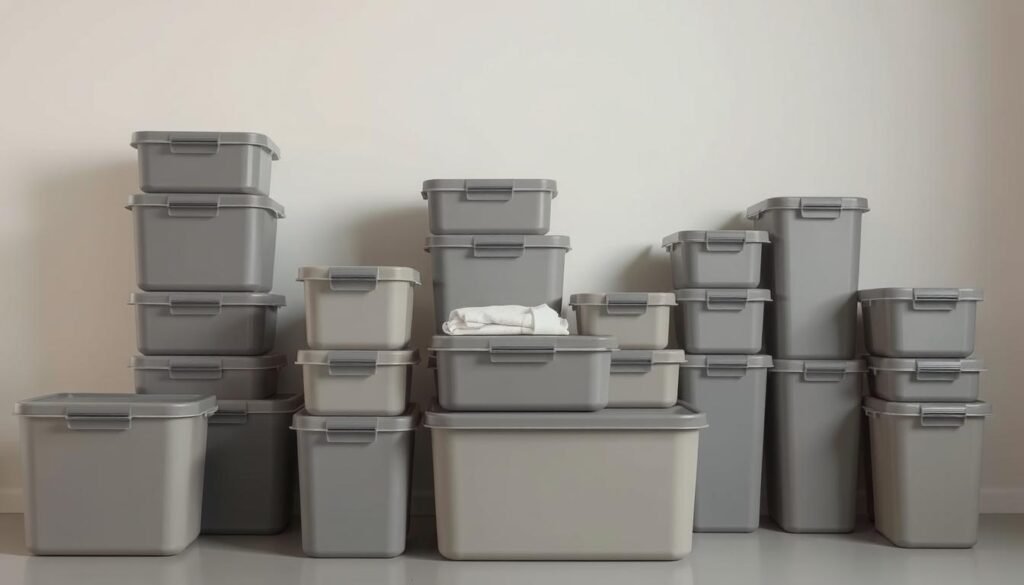
Plastic Containers vs. Cardboard Boxes
When picking storage containers, plastic bins are better. They protect clothes from moisture, pests, and dust better than cardboard boxes. Cardboard can attract pests and soak up moisture, harming baby clothes.
Experts say unwashed clothes can get moldy. This can cause bad smells and damage over time. Plastic bins are more durable and keep clothes safe and dry.
- Plastic bins last longer and are more durable.
- Cardboard boxes can attract pests and soak up moisture.
- They offer better protection against dust and dirt.
- They can be stacked to save space.
Considering Climate-Controlled Storage Units
For very delicate or valuable baby clothes, you might need climate-controlled storage. These units keep a steady temperature and humidity. This is perfect for storing clothes for a long time.
These units stop clothes from getting damaged by extreme temperatures. We suggest using wooden or padded hangers in wardrobe boxes for delicate clothes. Also, label your storage bins well for easy organization and access.
A big plastic bin (about 50 quarts) can hold a whole season’s clothes. The best plastic bin from Target is 41 quarts. Climate-controlled units give extra peace of mind by keeping your items safe and undamaged.
- Keep a steady temperature and humidity.
- Stop fabric damage from extreme temperatures.
- Great for delicate or valuable clothes.
- Use wooden or padded hangers in wardrobe boxes.
We stress the need for protective storage solutions to keep baby clothes in good shape. Refolding clothes every one to two years helps prevent creases. Make sure clothes are dry before storing to avoid mildew or mold.
How to Store Baby Clothes Long Term
When planning for long-term clothes preservation, we must think about protection and space. Let’s look at some good ways to store baby clothes and keep them in great shape.
Using Vacuum Seal Bags
Vacuum seal storage is a great way to keep baby clothes fresh. It stops air from getting in, which can cause damage. These bags also save a lot of space, which is good since babies grow out of clothes fast.
Parents find vacuum packing great for clothes under 6 months. It keeps clothes dry and stops moisture damage. Using space up high in closets or under beds can also help a lot.
Protecting Fabrics with Acid-Free Tissue Paper
For special or delicate clothes, use acid-free tissue paper. It keeps colors bright and fabrics strong. This is important because many clothes get damaged when stored wrong.
About 60% of parents save clothes for future babies or to give away. So, keeping them in good shape is very important. Acid-free tissue paper stops damage from acids that can make clothes yellow or weak. Using it with airtight containers adds extra protection.
| Storage Method | Benefits |
|---|---|
| Vacuum Seal Storage | Reduces space by up to 50%, protects from air exposure and moisture |
| Acid-Free Tissue Paper | Prevents discoloration and fabric breakdown, essential for delicate fabrics |
| Plastic Bins | Reduces moisture damage risk by up to 80%, easy to stack and organize |
| Climate-Controlled Storage | Extends fabric lifespan by 30%, maintains stable temperature and humidity |
In conclusion, using vacuum seal storage saves space, and acid-free tissue paper keeps clothes looking new. The right storage keeps baby clothes in great shape for a long time. This way, we can keep memories and clothes safe for the future.
Organizing Baby Clothes for Easy Retrieval
It’s key to organize baby clothes well. This is because babies grow fast and seasons change. Parents need a simple way to store all items for quick access.
Labeling Systems
A good labeling system is vital for organizing baby clothes easily. Use clear clothing labels to know the size, type, and season of each item. Here are some tips:
- Label bins with the current size range, such as “0-3 months” or “3-6 months”.
- Include the type of clothing, like “Bodysuits”, “Pants”, or “Sleep Sacks”.
- Add the season, such as “Winter” or “Summer”, to help with seasonal storage tips.
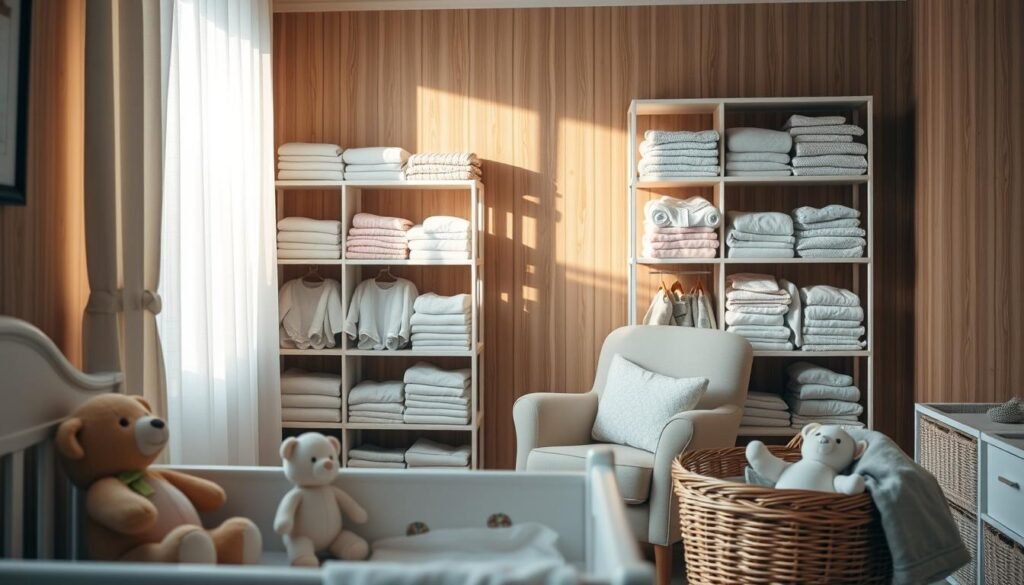
Storage by Size, Type, and Season
Store baby clothes by size, type, and season. This makes it easy to switch between sizes and seasons. Here’s how to do it:
| Size Category | Recommended Items | Seasonal Tips |
|---|---|---|
| Newborn |
|
|
| 0-3 Months |
|
|
| 3-6 Months |
|
|
Update your storage every three months. This helps find missing items and keeps space tidy.
Long-Term Preservation of Heirloom Baby Clothes
Keeping heirloom baby clothes in good shape is key. You need to clean and store them right to keep them for years.
Special Washing Instructions
Heirloom baby clothes are made of soft fabrics like silk and fine cotton. To wash them safely:
- Hand wash or use a gentle machine cycle with cold water.
- Don’t use strong detergents; mild, fragrance-free soap is best.
- Soak them for a short time to avoid fiber damage.
- Rinse well to get rid of soap, which pests might be attracted to.
Dealing with Delicate Fabrics
It’s important to care for delicate fabrics in heirloom clothes:
- Press them gently between towels to dry without wringing.
- Let them air dry flat on clean towels, away from sunlight.
- Use acid-free tissue paper to fold and store them to avoid creases.
Preparing Accessories Like Booties and Hats
Booties and hats need special care to keep their shape:
- Stuff them with acid-free tissue paper to keep their shape.
- Wrap each one in acid-free tissue paper to protect the material.
- Store them in breathable bags like cotton muslin to avoid moisture.
To keep pests away, add natural moth repellents like lavender sachets to your storage.
| Item | Recommended Cleaning Method | Storage Recommendations |
|---|---|---|
| Heirloom Garments (e.g., gowns, special-occasion outfits) | Hand wash or gentle machine cycle with cold water | Fold with acid-free tissue paper, store in breathable containers |
| Accessories (e.g., booties, hats) | Spot clean as required | Stuff with acid-free tissue paper, wrap individually |
Natural Methods to Keep Moths Away
Keeping clothes safe for a long time is key, even more so for baby clothes. Using herbs and other natural solutions is a great way to protect fabrics. It also makes sure the clothes are safe for kids.
Using Lavender and Other Herbs
Dried herbs are a top choice for moth repellent. Lavender is famous for keeping pests away. Its smell is nice, making it a favorite in homes.
You can also mix lavender with rosemary, mint, thyme, and cloves. Put these herbs in small bags and put them in storage places.
Herbs are a green way to keep moths away. They stop moths from laying eggs on clothes. This way, we keep baby clothes in good shape without using harsh chemicals.
Proper Placement of Moth Repellents
Where you put these repellents matters a lot. Make sure to spread them out in storage places. Put them in corners, near openings, and between clothes layers.
In closets, hang them on hangers or on storage bins. Cedar wood is also great for keeping pests away. You can put it in drawers or hang it in closets. But, cedar’s smell fades over time, so you need to replace it every few years.
Using these natural methods helps keep moths away and keeps baby clothes in great shape. These methods protect clothes and are good for the environment. They help make a healthier home for our kids.
Best Practices for Storing Clothes in Small Spaces
Living in small spaces means every inch counts. Professional organizer Ellen Delap says to use every bit of closet space. She also suggests using under-bed organizers for creative storage. These tips help you store baby clothes efficiently, even in tiny spaces.
Under-Bed Storage Solutions
Under-bed storage is a smart way to hide clothes while keeping them easy to find. Use plastic bins with lids to keep clothes dry and pest-free. Label each bin by season and size for quick access.
Delap suggests using weather-tight containers from The Container Store or Amazon. This keeps clothes in great shape.
Closet Organizers and Shelving Units
To make the most of your closet, add adjustable shelving and multi-level rods. This creates more space. Stackable boxes are perfect for vertical storage, great for big families.
Labeling containers on both sides makes them easy to find, no matter how they’re stacked. Also, breathable garment bags are key for storing special or delicate items.
Using these storage tips keeps your baby clothes organized and accessible, even in small spaces. Regularly reorganizing helps keep your home tidy and functional!
FAQ
Why is proper storage of baby clothes important?
Storing clothes right keeps them looking good for a long time. It stops mold, damage, and pests. This way, clothes stay in good shape and keep their special meaning.
What are common problems with improper storage of baby clothes?
Bad storage can cause mold, damage, pests, and harm from too hot or cold. This makes clothes useless later.
How should I launder baby clothes before storing them long-term?
Wash with gentle soap and dry completely to avoid mildew. Don’t use fabric softeners, as they can harm the fabric.
What are the best drying techniques for baby clothes before storage?
Dry clothes in the shade to avoid heat damage. Make sure they’re dry to stop mildew and mold.
How does fabric softener impact the storage of baby clothes?
Fabric softeners can weaken fabric fibers. This can make clothes less comfortable and last shorter when used again.
Are plastic containers better than cardboard boxes for storing baby clothes?
Yes, plastic containers are better. They keep clothes dry and safe from pests and light damage. Cardboard boxes can get wet and attract pests.
When should I consider using climate-controlled storage units?
Use climate-controlled units for very delicate or valuable clothes. They keep clothes safe from extreme temperatures that can damage fabric.
Can vacuum seal bags be used for long-term storage of baby clothes?
Yes, vacuum seal bags save space and protect clothes. But for special or delicate fabrics, use acid-free tissue paper in airtight containers.
What’s the best way to protect heirloom baby clothes in storage?
Wrap special clothes in acid-free tissue paper and store in airtight containers. Follow special washing tips for delicate fabrics like silk and fine cotton.
How can I organize baby clothes for easy retrieval?
Use labels with size, type, and season on each container. This makes finding clothes fast and keeps things tidy.
What are some natural methods to keep moths away from stored baby clothes?
Use natural repellents like lavender, cedar, and herbs to keep moths away. Place them where they can do the most good.
What storage solutions work best for small living spaces?
Use under-bed storage, closet organizers, and shelves to save space. This keeps things neat and easy to find.

